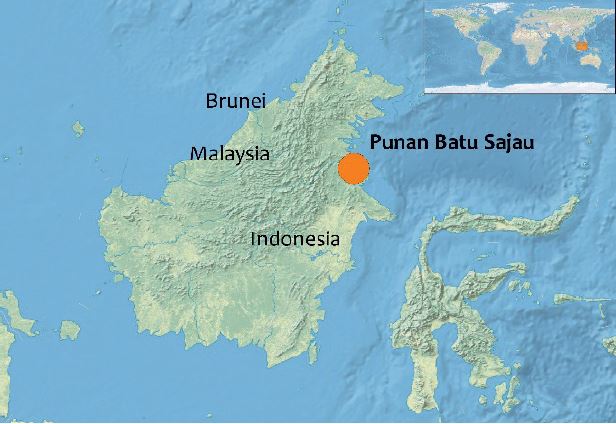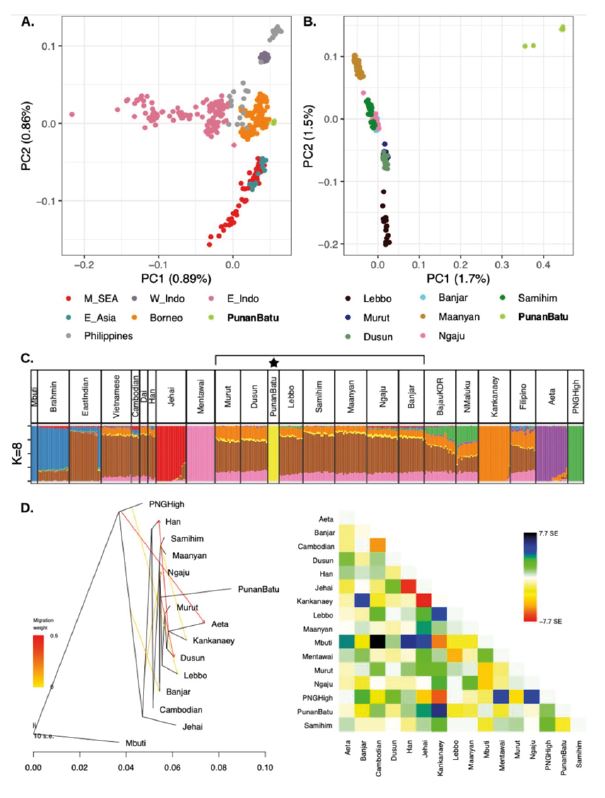Cave Punan – Borneo, Indonesia


Description
- Principal investigator: J. Stephen Lansing
- Research since: 2018
Site details
The last remaining nomadic hunter-gatherers in Borneo
Theories of early cooperation in human society often draw from a small sample of ethnographic studies of surviving populations of hunter-gatherers, most of which are now sedentary. Borneo hunter-gatherers (Punan, Penan) have seldom figured in comparative research because of a decades-old controversy about whether they are the descendants of farmers who adopted a hunting and gathering way of life. In 2018 we began an ethnographic study of a group of still-nomadic hunter-gatherers who call themselves Punan Batu (Cave Punan). To investigate their ancestry and relationship to one another and neighboring groups, we combined multiple independent lines of evidence from ethnology, population genetics and linguistic analysis to provide the first comprehensive cultural-genetic-linguistic study of the only known group of Punan hunter-gatherers who remain continuously mobile.
Scientific questions to be investigated follow from the discovery that the Punan Batu possess a unique ancestral genetic signature and form a genetic cluster distinct from neighboring tribal peoples of Borneo. Their divergent status over multiple independent genetic analyses, indicates that the Punan Batu have long been genetically seperate from nearby agriculturalists, and have experienced substantial genetic drift likely due to a combination of cultural endogamy and long-term genetic isolation. Estimating the genetic ancestry of individual people using ADMIXTURE reveals a single unique Punan-specific ancestral component. The Punan Batu also show long intra-population IBD segments and long runs of homozygosity (ROH), both consistent with long-term isolation. In combination this unique ancestral genetic signature of the Punan Batu, and their divergent status over multiple independent genetic analyses, indicates that the Punan Batu have long been genetically seperate from nearby agriculturalists, and have experienced substantial genetic drift likely due to a combination of cultural endogamy and long-term genetic isolation.
Evidence from language is consistent with these inferences. The everyday spoken language of the Punan Batu is Punan Sajau, a Central Sarawakan Austronesian language which is related to those of their close neighbors. But some are also fluent in a hitherto undocumented language which is not spoken, but rather sung, customarily at night in the rock shelters or caves. This song language, Latala or Menirak (‘to sing’ in the daily Punan language), is known only to the Punan Batu, though it shares some formal features with other ritual song languages of Borneo. An internal subgrouping of Punan dialects recognizes a primary split between Punan Sajau, Tubu and Bah (the closest Punan neighbors of the Punan Batu and the other Punan groups. Thus, the retention of a divergent song language by the Punan Batu is most parsimoniously explained as an ancient cultural inheritance, which is consistent with the genetic evidence for prolonged isolation.
Research
The scientific questions to be pursued in this project follow from these preliminary results, which indicate that the Punan Batu are independent mobile hunter-gatherers, probably the only remaining nomadic culture in Borneo. Pilot research showed that they move on average about once in 8-9 days for distances of ~4.5 km, and that group membership varies. A major focus of research will be gathering data to improve our understanding of the adaptive significance of their mobility. How do individuals and groups decide when to move, interact, fracture and combine? How is information shared between dispersed groups? What are the reasons for leaving a site? Do mobility patterns change depending on the sex or age of the individuals (e.g. older people travel shorter distances? young men travel longer distances?) Is there sex bias in mobility patterns? What are the reasons for leaving a site? Or to travel shorter or longer distances? Further questions pertain to diet and food sharing. Do the Punan Batu possess cognitive maps of the seasonal availability of different types of food? Is food immediately shared with everyone in a traveling group? Do they practice demand sharing?
A second major area of research is kinship and demography. Data on kinship terminology, marriages and geneaologies will be collected, and analyzed in the context of the composition of traveling groups. These questions will be pursued using small, robust personal remote sensing devices to generate detailed joint movement (GPS tracks) and social network (proximity sensor) maps of mobile groups. This information will be linked with dietary surveys.
A third major focus is their song language, Latala. Other ritual Bornean song languages are typically closely related to their spoken language, and do not resemble the song language of the Punan Batu. Latala appears to be only distantly related to both Austroasiatic, Austronesian and other song languages, as well as the everyday spoken language of the Punan Batu. Songs and commentaries on the songs will be recorded and analyzed. The Punan Batu say that the songs should be sung at night, in the caves, and are often sung as improvised duets. Knowledge of Latala varies and only a few persons are considered fully competent. The aim of this part of the project is to obtain a large corpus of songs, translations and commentaries.
A fourth focus is the collection of DNA samples from individuals not yet included in the study, from the fringes of the territory of the Punan Batu, and more distant Punan groups such as the Punan Tubu whose spoken language is closely related to the language of the Punan Batu, to further probe the unique ancestral genetic signature in the Punan Batu.
All of these studies are intended to provide data for analysis and scientific publication. Two genres of publication are anticipated: articles on the specific topics described above, and broader studies of the Punan Batu in the context of the comparative study of hunter-gatherers.
These studies are intended to benefit the Punan Batu because they wish to secure recognition as a customary community with the legal standing to assert rights over their ancestral domain. Under Indonesian law, to qualify as a customary law community entitled to claim ancestral rights to natural resources in a specific locality, the community must consist of “people who for generations have lived in a certain geographical area in the Republic of Indonesia because of ties to ancestral natural resources and have traditional governance institutions and an indigenous legal structure in their traditional territory” (Law 39/2014 on Plantation Development, article 1(6)). For that purpose, the analysis of their ancestry, song language, diet, mobility and relationship to their forests will be relevant.
Representative publications
Lansing, J. S., Jacobs, G. S., Downey, S. S., Norquest, P. K., Cox, M. P., Kuhn, S. L., Miller, J. H., Malik, S. G., Sudoyo, H., & Kusuma, P. (2022). Deep ancestry of collapsing networks of nomadic hunter-gatherers in Borneo. Evolutionary Human Sciences, 4, e9. doi:10.1017/ ehs.2022.3.
Lansing, J. S. et al. (under review). Beyond expansion: Deep ancestry of Bornean hunter-gatherers supports long-term local ancestry dynamics.
